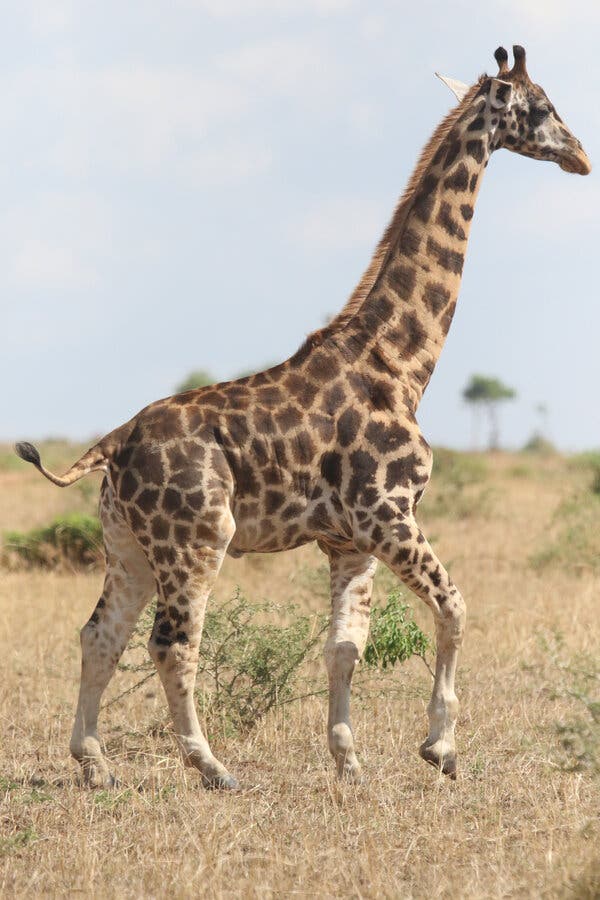Like someone put a giraffe’s head and neck on a horse’s body.
https://i.imgur.com/dHJKsbH.jpg
A dwarf giraffe, right, with an adult male in Namibia. Dwarfism, or skeletal dysplasia, is rare among wild animals and this is the first time it has been observed among giraffes.Credit…Emma Wells
With an average height of roughly 16 feet, giraffes are the tallest mammals on Earth. At about 6 feet long, their lanky legs and towering necks stand taller than most humans. Even the shortest giraffe is twice as tall as the average professional basketball player.
So when Michael Brown, a conservation science fellow with the Giraffe Conservation Foundation and the Smithsonian Conservation Biology Institute, and colleagues came across a Nubian giraffe in Uganda’s Murchison Falls National Park in 2015 that was just 9 feet, 4 inches tall, they did a double-take.
“The initial reaction was disbelief,” Dr. Brown said.
The neck on the giraffe — nicknamed Gimli — was characteristically long, but its legs weren’t. It looked like someone had put a giraffe’s head and neck on a horse’s body.
Then, just three years later, an 8-1/2-foot-tall Angolan giraffe — nicknamed Nigel — was found living on a private farm in central Namibia. After measuring and analyzing the dimensions of the two giraffes, the researchers could come up with only one explanation: dwarfism.
The condition, also known as skeletal dysplasia, affects bone growth, often resulting in short stature. Although it has been known to occur in humans and domestic animals like dogs, cows and pigs, dwarfism is rarely observed among wild animals and this is the first time it has been found in giraffes.
The discovery, announced in an article published last month in the journal BMC Research Notes, has created a unique opportunity for scientists to study the effects of dwarfism on free-ranging wild animals.
When photos of the dwarves began circulating online, many people assumed the images had been manipulated.
“I didn’t believe it at first,” said David O’Connor, president of Save Giraffes Now and member of the IUCN Giraffe and Okapi Specialist Group. “I thought it was photoshopped, to be honest.”

A dwarf giraffe observed in Uganda in 2017.Credit…Michael Brown
The researchers who discovered Gimli and Nigel photographed the creatures extensively and used digital photogrammetry techniques to measure the length of their appendages. After comparing the dimensions of the dwarf giraffes, both mature males, to those of similar age from the same populations, they found that the dwarves had much shorter legs; more specifically, they had much shorter radius and metacarpal bones.
More than half of wild giraffes die before reaching adulthood, so the fact that both Gimli and Nigel beat the odds suggests their dwarfism hasn’t hindered their ability to survive. However, their height, or lack thereof, almost certainly makes many aspects of their lives difficult.
“It’s easy to imagine how this might make them more susceptible to predation since they lack the ability to effectively run and kick, which are two of the giraffe’s most effective anti-predator tactics,” Dr. Brown said. “Additionally, given the mechanics of giraffe mating, I’d speculate that for both of these giraffes, mating would be physically challenging.”
Even though female giraffes tend to be shorter than males, it would be nearly impossible for an 8 or 9-foot male to mount even the shortest female “unless they get a stepping stool,” Mr. O’Connor said.
The cause of this dwarfism remains a mystery. Although random mutations can give rise to the condition, dwarfism in captive animals has been associated with inbreeding and a lack of genetic diversity. Whether these factors influenced Gimli’s and Nigel’s dwarfism remains unclear.
The giraffe population that includes Gimli experienced a significant decline during the late 1980s that at one point diminished the total to just 78 animals. It now consists of more than 1,500 individuals. More research is needed to determine if a lack of genetic diversity caused Gimli’s condition.
Although scientists know very little about giraffes compared with other iconic animals, they do know that the towering mammals are in trouble. Habitat loss and poaching have reduced their numbers by an estimated 40 percent in the last 30 years, and some subspecies, including the Nubian giraffe, are now critically endangered. To combat this decline, Dr. Brown and other scientists have been surveying and monitoring as many wild giraffe populations as they can.
“Population surveys are a critical component of our mission to develop effective conservation strategies rooted in solid science,” Dr. Brown said.
Nigel was spotted during a foundation-led survey in July 2020, but Gimli hasn’t been seen since March 2017. The researchers hope that both giraffes will show up again soon.
By monitoring them over the course of their lives, the scientists hope to “get some interesting stories and neat little wrinkles about how animals that have these types of conditions cope with changing environments,” Dr. Brown said.